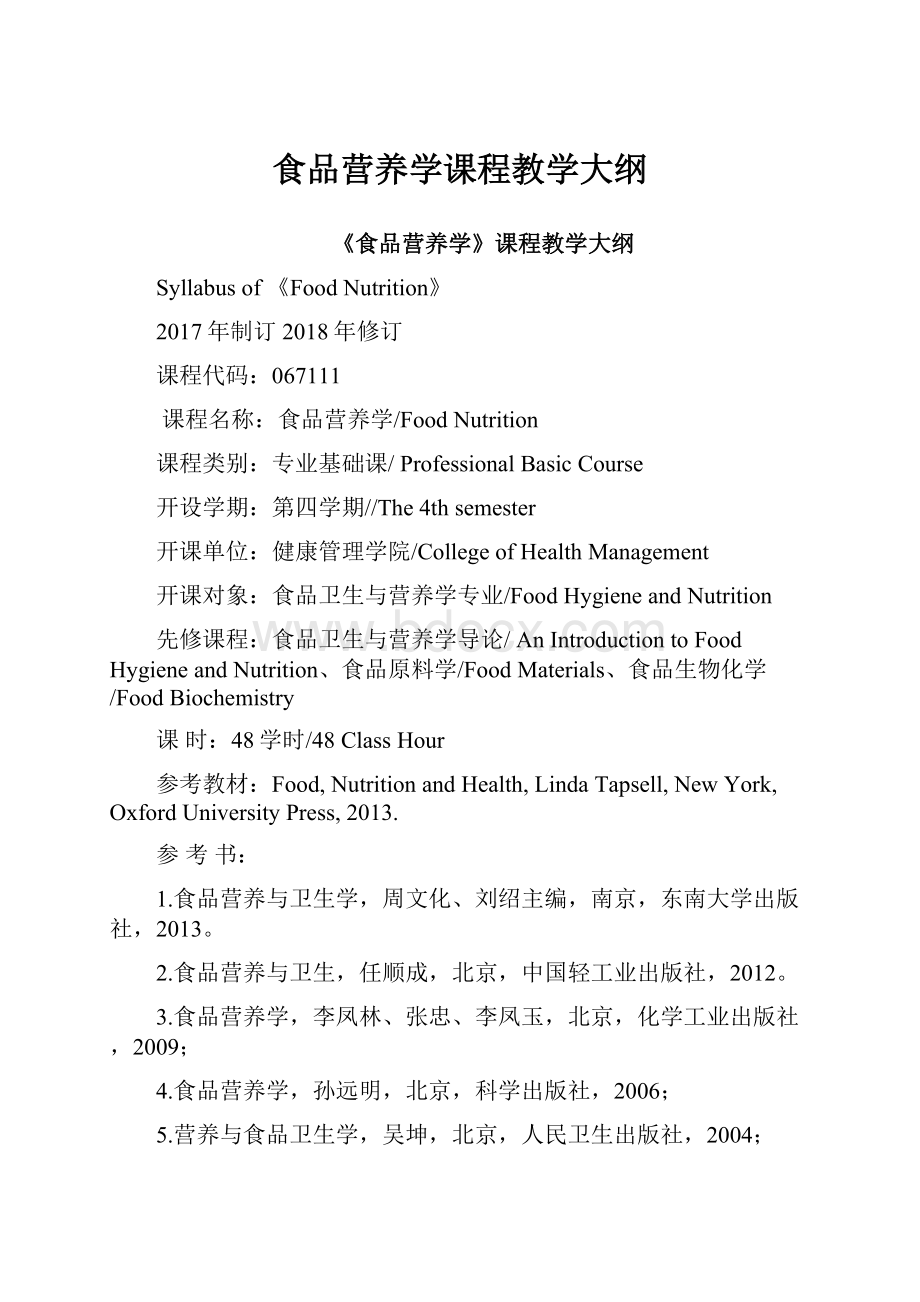食品营养学课程教学大纲.docx
《食品营养学课程教学大纲.docx》由会员分享,可在线阅读,更多相关《食品营养学课程教学大纲.docx(18页珍藏版)》请在冰豆网上搜索。

食品营养学课程教学大纲
《食品营养学》课程教学大纲
Syllabusof《FoodNutrition》
2017年制订2018年修订
课程代码:
067111
课程名称:
食品营养学/FoodNutrition
课程类别:
专业基础课/ProfessionalBasicCourse
开设学期:
第四学期//The4thsemester
开课单位:
健康管理学院/CollegeofHealthManagement
开课对象:
食品卫生与营养学专业/FoodHygieneandNutrition
先修课程:
食品卫生与营养学导论/AnIntroductiontoFoodHygieneandNutrition、食品原料学/FoodMaterials、食品生物化学/FoodBiochemistry
课时:
48学时/48ClassHour
参考教材:
Food,NutritionandHealth,Linda Tapsell,NewYork,OxfordUniversityPress,2013.
参考书:
1.食品营养与卫生学,周文化、刘绍主编,南京,东南大学出版社,2013。
2.食品营养与卫生,任顺成,北京,中国轻工业出版社,2012。
3.食品营养学,李凤林、张忠、李凤玉,北京,化学工业出版社,2009;
4.食品营养学,孙远明,北京,科学出版社,2006;
5.营养与食品卫生学,吴坤,北京,人民卫生出版社,2004;
6.食品营养学,王光慈,北京,中国农业出版社,2001;
课程概述:
食品营养学是食品卫生与营养学专业的一门专业基础课。
食品营养学是研究人体营养规律以及改善措施的科学,即研究食物中对人体有益的成分及人体摄取和利用这些成分以维持、促进健康的规律和机制。
它的研究对象是食物与人,即研究食品与健康的关系。
食品营养学部分以基础营养学为核心,主要由基础营养学、特殊人群营养、营养与健康、公共营养四部分组成。
FoodNutritionisanimportantprofessionalbasiccourseforthemajorofFoodHygieneandNutrition.Foodnutritionisthesubjectareawherethenutritionconditionofhumanbodyandrelevantimprovementmeasures,includingthebeneficialingredientsinfoodandtheircorrespondingabsorptionandutilizationmechanismbyhumanbody,isstudied.Thestudyingobjectisfoodandhumanbody,aswellastherelationshipbetweenfoodandhealth.Foodnutritionconsistsofbasicnutrition,nutritionfordifferentpopulations,nutritionandhealth,andpublicnutrition,andfoodnutritionisthemostimportantpart.
教学要求:
1.掌握食品营养学的基本知识和基本概念,合理营养的基本要求。
Tomasterthebasicknowledgeandconceptsoffoodnutrition,andthebasicrequirementsofrationalnutrition.
2.掌握各类营养素的生理功能、缺乏症、供给量标准和食物来源;不同人群的生理特点及营养需求。
Tomasterthefunctions,deficiencies,normalintakeandfoodsourcesofvariousnutrients,aswellasthephysiologyandnutritionalneedsofdifferentpopulations.
3.普及营养学知识,理解营养与疾病的关系,理解营养与机体健康的关系,为营养配餐奠定良好的基础。
Topopularize nutritionscience,understandtherelationshipbetweennutritionandchronicdisease,aswellasthenutritionandthehealthofhumanbody,inordertoprovidemealswithgoodnutritionandflavorfordifferentpopulations.
4.掌握食品营养学的基本理论和基本技能,可以进行简单的营养食谱设计,为今后从事食品营养学及相关工作奠定基础。
Tomasterthebasictheoryandskillsoffoodnutrition,andtocarryoutsimplenutritionrecipedesignwhichisessentialinthefuture work.
教学重点:
1.营养学基础:
营养素与能量,各类食物的营养保健特性。
FundamentalsofNutrition:
nutrientsandenergy,nutritionalcharacteristicsofdifferentfood.
2.营养学的应用:
膳食营养与健康,不同人群的营养,公共营养。
ApplicationofNutrition:
dietarynutritionandhealth,nutritionfordifferentpopulationsandpublicnutrition.
教学难点:
1.三种宏观营养素的营养价值评价,不同食物的营养保健特性。
Threemacronutrients:
protein,fatandcarbohydrates;nutritionalcharacteristicsofdifferentfood.
2.各类与营养相关疾病膳食原则,不同人群的合理营养及合理平衡膳食的食谱编制,膳食调查。
Thenutritionanddietprinciplesfordifferent chronicdiseasepatients,therationalandbalanceddietaryguidelinesfordifferentpopulations,Nutrition anddietsurvey.
学时分配(TeachingContentsandPeriodsAssignment):
章节
主要内容
各教学环节学时分配
备注
Notes
讲授
Lecture
实验
Experiment
讨论
Discuss
习题
Exercise
课外
OutsideClass
设计
Others
合计
Total
第一章
Chapter1
NutrientsandEnergy
绪论
Introduction
2
2
第二章Chapter2
营养素与能量
NutrientsandEnergy
12
16
30
第三章Chapter3
食品的消化与吸收
DigestionandAbsorption
4
4
8
第四章Chapter4
各类食物的营养保健特性
NutritionalValueofdifferentkindsofFood
8
8
16
第五章
Chapter5
膳食营养与健康
DietaryNutritionandHealth
2
4
6
第六章
Chapter6
不同人群的营养
DietaryNutritionvariousindividuals
2
4
6
第七章
Chapter7
公共营养
PublicNutrition
4
4
第八章
Chapter8
食品营养强化
FoodNutritionEnrichment
2
4
6
第九章
Chapter9
营养强化食品、保健食品与营养标签
Nutrition-intensified food,healthfoodandnutritionlabel
4
4
合计
Total
40
32
8
80
各章教学要求及教学要点
第一章绪论/Introduction学时/ClassHour:
2
教学要求:
1.掌握食品营养学的基本概念以及与人体健康的关系;
Tomasterthebasicknowledgeandconceptsoffoodnutrition,andthecorrespondingrelationshipwithhumanbody.
2.了解食品营养学的发展历程与新进展;
Tolearnthedevelopingprocessandlatestadvanceprogressoffoodnutrition.
3.熟悉食品营养学的研究任务和内容及其与相关学科的关系;
Tobefamiliarwiththeresearch tasks, research contentoffoodnutritionandtherelationshipwithothersubjects.
4.了解本课程的课程结构、特点和学习方法。
Tolearnthestructure,characteristicsandstudyingmethodsoffoodnutritioncourse.
教学内容/Teachingcontents:
1.食品营养学的概念及研究内容、研究任务;
DefinitionsofFoodnutrition,contentsandtargetsofnutrition.
2.食品营养学的发展历史和展望;
Developingofnutrition,the latest trendofNutrition.
3.本课程与其他学科的关系及重要地位
Therelationshipofnutritionwithothersubjects,theimportanceofnutrition.
4.本门课程基本结构
Thestructureoffoodnutritioncourse.
第二章营养素与能量学时:
14
教学要求:
1.掌握人体基础代谢、食物热效应、氨基酸模式、蛋白质互补作用、限制性氨基酸、必需脂肪酸等概念;蛋白质、脂类、碳水化合物的生理功能及其各自的分类等;维生素的分类、共同特点和缺乏症的原因;各种矿物质的生理功能、吸收与代谢、缺乏症与过量、参考摄入量与及食物来源。
Tomastertheconceptsofbasicmetabolism,foodthermaleffect,aminoacidpattern,proteincomplementation,restrictedaminoacid,essentialfattyacid,etc.Tolearnphysiologicalfunctionsandclassificationofproteins,lipidsandcarbohydrates;Classificationofvitamins,commoncharacteristicsandcausesofdeficiency;Physiologicalfunction,absorptionandmetabolism,deficiencyandexcess,referenceintakeandfoodsourcesofvariousminerals.
2.熟悉影响人体能量消耗的因素;食物蛋白质营养价值的主要评价指标以及蛋白质互补作用在食品营养中的部分应用;油脂营养价值的评价指标;碳水化合物在食品加工中的变化及其供给量和食物来源。
各种维生素的理化性质、生理功能、吸收与代谢、缺乏症和过量、参考摄入量与膳食来源;矿物元素的共同特点和生理功能,水的生理功能。
Tolearnthefactorsthataffecthumanenergyconsumption;Themainevaluationindexesoffoodproteinnutritionvalueandsomeapplicationsofproteincomplementarityinfoodnutrition;Evaluationindexofnutritionalvalueofoil;Changesofcarbohydrateinfoodprocessing,itssupplyandfoodsource.Tolearnthephysicalandchemicalproperties,physiologicalfunctions,absorptionandmetabolism,deficiencyandexcess,referenceintakeanddietarysourcesofvariousvitamins;Thecommoncharacteristicofmineralelementandphysiologyfunction,physiologyfunctionofwater.
3.了解人体能量消耗整个过程;理解蛋白质代谢的氮平衡;食品加工中蛋白质和氨基酸的变化,熟记膳食蛋白质供给量及主要优质食物来源;食品加工中脂类的变化以及脂类的供给量和食物来源;维生素在食品加工中的变化。
熟记人体营养物质中矿物元素的分类;了解矿物质在食品加工中的变化,不同概念的水及其健康的关系。
Tolearnthewholeprocessofenergyconsumption;Nitrogenbalanceinproteinmetabolism;Changesinproteinandaminoacidsinfoodprocessing,keepinginminddietaryproteinsupplyandmajorsourcesofqualityfood;Changesinlipidsinfoodprocessing,theirsupplyandfoodsources;Changesinvitaminsinfoodprocessing.Tomemorizetheclassificationofmineralelementsinhumannutrition.Tolearnmineralchangesinfoodprocessing;differentconceptsofwaterandtheirrelationshiptohealth.
4.熟悉人体能量消耗的测定方法并了解能量的供给量标准与食物来源以及蛋白质节约作用、抗生酮作用。
Tolearnthemeasurementmethodofenergyconsumptionofhumanbodyandunderstandthestandardofenergysupplyandfoodsourceaswellasthefunctionofproteinconservationandanti-ketogenesis.
教学内容:
1.能量的来源与能量系数;人体能量消耗的构成因素,能量平衡及其影响因素;人体能量消耗的测定与计算;能量的供给量与食物来源。
Energysourceandenergycoefficient;Theconstitutionofenergyconsumption,energybalanceanditsinfluencingfactors;Determinationandcalculationofhumanenergyconsumption;Energysupplyandfoodsources.
2.蛋白质的分类及其生理功能;氨基酸的分类;必需氨基酸、氨基酸模式、限制性氨基酸、蛋白质互补作用的定义及相关应用;食物蛋白质的营养价值评价;蛋白质的代谢及氮平衡;蛋白质与健康:
蛋白质营养不良,蛋白质在食品加工中的变化,蛋白质的参考摄入量及食物来源。
Classificationofproteinsandtheirphysiologicalfunctions;Classificationofaminoacids;Definitionandapplicationofessentialaminoacids,aminoacidpatterns,restrictedaminoacidsandproteincomplementarity;Nutritionalvalueevaluationoffoodprotein;Proteinmetabolismandnitrogenbalance;Proteinandhealth:
proteinmalnutrition,proteinchangesinfoodprocessing,proteinreferenceintakeandfoodsources.
3.脂类的分类、生理功能;脂肪酸的分类及其生理功能;脂类的营养价值评价;脂类与健康。
Classificationandphysiologicalfunctionsoflipids;Theclassificationandphysiologicalfunctionoffattyacids;Nutritionalvalueevaluationoflipids;Lipidsandhealth.
4.碳水化合物的分类;碳水化合物的生理功能;碳水化合物与健康:
碳水化合物在食品加工中的变化;食物的血糖指生成指数;碳水化合物的参考摄入量与食物来源。
Classificationofcarbohydrates;Thephysiologicalfunctionofcarbohydrates;Carbohydrateandhealth:
carbohydratechangesinfoodprocessing;Foodglycemicindex;Carbohydratereferenceintakeandfoodsources.
5.维生素的概念、共同特点、分类、缺乏症的原因;脂溶性维生素A、D、E、K的理化性质、生理功能、吸收与代谢、缺乏症和过量、参考摄入量与膳食来源。
水溶性维生素C、B1.B2.PP、B6.B12.叶酸、泛酸、生物素、钴胺素的理化性质、生理功能、吸收与代谢、缺乏症和过量、参考摄入量与膳食来源。
Theconceptofvitamins,commoncharacteristics,classificationandcausesofdeficiency;Physicalandchemicalproperties,physiologicalfunctions,absorptionandmetabolism,deficiencyandexcess,referenceintakeanddietarysourcesoffat-solublevitaminsA,D,EandK.Water-solublevitaminsC,b1.b2.PP,b6.b12.Physicalandchemicalproperties,physiologicalfunctions,absorptionandmetabolism,deficiencyandexcess,referenceintakeanddietarysourcesoffolicacid,pantothenicacid,biotinandcobalamin.
6.矿物元素的分类、共同特点和生理功能;具体介绍钙、磷、镁、钾、钠、铁、碘、锌、硒、铜、氟等矿物质的生理功能、吸收与代谢、缺乏症与过量、参考摄入量与及食物来源等。
水在人体的含量,水的生理功能,人体对水的需要与水平衡,不同概念的水及其健康的关系等。
Classification,commoncharacteristicsandphysiologicalfunctionsofmineralelements;Thephysiologicalfunctions,absorptionandmetabolism,deficiencyandexcess,referenceintakeandfoodsourcesofmineralssuchascalcium,phosphorus,magnesium,potassium,sodium,iron,iodine,zinc,selenium,copperandfluorineareintroducedindetail.Watercontent,thephysiologicalfunctionofwater,thehumanbody'sneedforwaterandwaterbalance,differentconceptsofwateranditshealthrelationship.
第三章食物的消化和吸收/Digestionandabsorptionoffood学时:
4
教学要求:
1.熟悉人体消化系统的组成和功能;
Tolearnthecompositionandfunctionofhumandigestivesystem
2.掌握吸收的部位和机理;
Tomasterthelocationandmechanismofabsorption
3.理解六大营养素的消化和吸收过程。
TounderstandtheDigestion